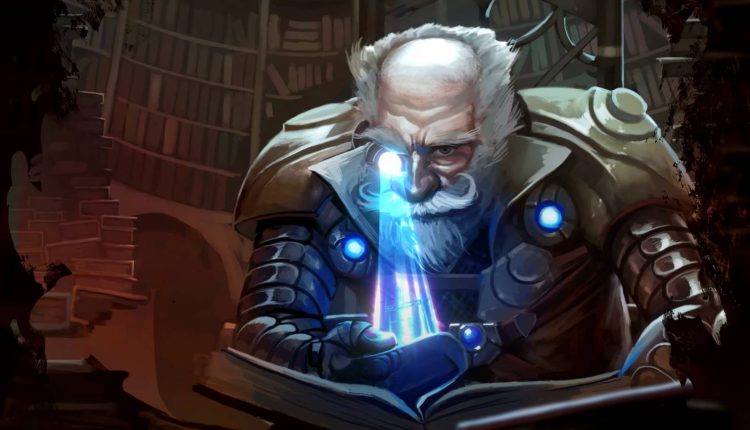SolForge Fusion and the power of digital ownership

Going from the cutting-edge of mobile gaming in 2012 to the disruptive power of web3 in 2024, co-developers Richard Garfield and Justin Gary recently revealed that hybrid deck-builder SolForge Fusion aims to stay at the forefront of the digital gaming industry by adopting blockchain.
We thought it’s a good time to check in with Stone Blade founder and SolForge co-creator Justin Gary to get more insights about the game, and what makes it different to other web3 TCGs.
Web3, and the Solana blockchain in particular, gave us an efficient way to give players that control and bring the great gameplay of SolForge Fusion to an entirely new audience.
Justin Gary, Stone Blade
BlockchainGamer: Can you give us some background to how and why the Stone Blade team has gone from mobile in 2012 to web3 games in 2024?

Gary: We are passionate about being at the forefront of gaming and technology. In 2012, we were at the cutting-edge of mobile games, launching SolForge as a native mobile game before any other TCGs. Today, the cutting-edge collectible games are in web3, and we are excited to bring true digital ownership to SolForge Fusion players.
In 2022 you launched SolForge Fusion, which initially was a tabletop game, in digital form. What main challenges did you encounter, and how will web3 help to solve them?
First, we had to build all of the technology to allow for algorithmically printing one-of-a-kind decks and letting those scan into your digital account to be played. For the physical game, you have to scan your deck in so that you can play it in tournaments, earn rewards, gain ranks for your deck, and even influence the story of the world of SolForge Fusion by participating in lore events.
Players who want to lend, trade, or sell their physical decks can simply unlock them from their account and do what they want with the deck. Now that we have launched the game in Early Access and players can buy digital-only decks, we want to give digital players the same freedom and control as physical players. Web3, and the Solana blockchain in particular, gave us an efficient way to give players that control and bring the great gameplay of SolForge Fusion to an entirely new audience.
SolForge Fusion is described as a hybrid deck-building game. How will it stand out among multiple other web3 games in this genre?
There are no other games like SolForge Fusion, especially on web3. An obvious standout feature is simply that SolForge Fusion is a fully realized game that players can experience right now. Most games on web3 don’t actually exist; they’re a promise of something to come.
SolForge Fusion was designed over many years by myself and Richard Garfield, the creator of Magic: the Gathering. It has over a million decks sold, and multiple high-level tournaments have been played. It has a team dedicated to its consistent refinement and boasts an existing community of players, rich lore, and regularly updated content.
It’s also the world’s only hybrid deck game existing in the physical and digital realm. Each deck is 100% unique, so no two players will ever have the same deck. You can also level up your deck by playing against other players or in our roguelike campaign mode, where you can battle bosses and find rare augments. It really does bring the best of multiple genres together.
- Do you enjoy the social interaction of physical games?
- Are you seeking online gameplay in solo, campaign, or player-vs-player modes?
- Are you interested in owning, trading, and competing with unique decks? SolForge Fusion has you covered.
A demo is currently available on Steam. How do you plan to attract that player base to a blockchain game?
The key is that this isn’t a “blockchain game” — it’s just a great game. Players aren’t interested in blockchain games. They are interested in great games, and SolForge Fusion is a great game, first and foremost. We have made clear to our players that the blockchain elements are opt-in. You don’t need it to play. We plan to show our audience (and new players coming in) the value of blockchain by offering features like minting and trading decks, great rewards, and a community-controlled fund. We believe players will opt into this experience because it adds value to the great game they already love. However, we also believe the key to reaching traditional gamers is not forcing the issue and letting the play and experience speak for itself.
How will web3 enhance the player experience?
First, it enables true digital ownership. Through blockchain technology, players own their digital assets securely and tangibly, much like physical card collecting, but with the added convenience of easy trading and management.
Players will also be able to earn token rewards and participate in decisions on how the community fund is managed, giving them more ownership of the game experience over time. Great games only exist because great communities are built around them. Web 3 gives us more tools to build and reward that community.
Many web3 games struggle with sustainability and long-term tokenomics. What’s your plan in this regard?
Step 1 is to have a great game people love and want to play. This is why we launched on tabletop and web2 first. Then, the key is to give the token actual utility that gives players more value and fun experiences. Then, distributing the token to those invested in the community through airdrops so they feel a sense of ownership and can experience the value-added directly.
Players aren’t interested in blockchain games. They are interested in great games, and SolForge Fusion is a great game, first and foremost.
Justin Gary, Stone Blade
Finally, there needs to be some humility. While the goal is, over time, to decentralize control of the community fund and key aspects of ownership in the game, this is not something we will do quickly or take lightly. Watching and learning how the community behaves and the economy evolves while maintaining some flexibility is critical to adjusting to the inevitable unexpected as the community develops.
Why did you choose to deploy on Solana?
After extensive research, Solana provided the best combination of reliable technology, energy-efficient transactions, and a great community. It is a perfect fit for SolForge Fusion. We found our SOLmate.
More generally, what’s your outlook on the blockchain gaming industry, and where do you see it in 5 years?
In general, I am bullish on this space. The main barriers to massive adoption will be overcome as better UI/UX and onboarding tools are developed. Then, a few killer games (like SolForge Fusion) will make the leap over, and players will follow the fun. As players get more accustomed to owning their digital goods (just like tabletop TCG players already are), they will begin to demand more of that from games, and adoption will increase.
Find out more via the SolForge Fusion website.

Comments are closed.